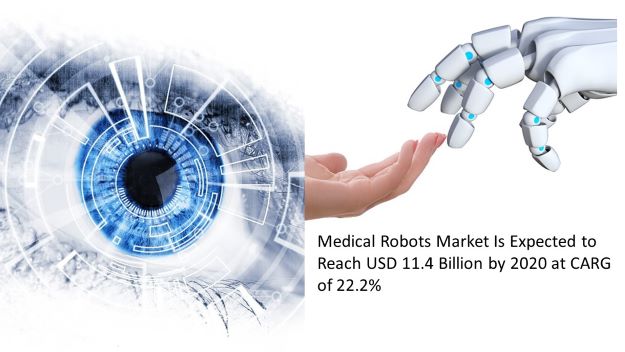The global medical robots market is segmented on the basis of segment, application and region. By segment, medical robots market is categorized into instruments and accessories and robotic systems.
Market Drivers for Medical Robots:
The growth of the global medical robots market can be majorly attributed to the following factors:
- Lack of healthcare professionals
- Need for better quality of life for disabled and aging population
- Rising need for better surgical procedures
- More focus on developing technologically advanced robots
- Market Scenario
The global medical robots market which was valued at $4.2 Billion in 2015 is predicted to reach $11.4 Billion by 2020, growing at a CAGR of 22.2% during the projected period.
In 2015, the North American market for medical robots held the largest market share among regions, followed by Europe and Asia-Pacific. However, Asia-Pacific is expected to be the key revenue pocket for this market, thus slated to grow at the highest CAGR. Rising aging population, increasing adoption rate of medical robots, increased cases of cancer, government initiatives and funding, and growing number of training programs in order to train surgeons for performing robot-assisted surgeries are the major factors responsible for the high growth in this region.
Based on product, the instruments & accessories segment accounted for the highest share of the market in 2015, and is also projected to grow at the highest rate over the forecast period. On the other hand, based on application, the laparoscopy segment held the largest market share in 2015, whereas the neurology segment is expected to witness the fastest growth.
Medical robots are set to revolutionize the healthcare sector, especially surgeries, since they are becoming more and more acceptable, globally. They not only help in reducing the time of surgery but also ensure the accuracy of the whole process coupled with better quality of patient care, thereby increasing the demand for surgical robots across the globe.
Da Vinci Surgical (Robot) System, the surgical assistant the US FDA approved back in 2000 has conducted more than 20,000 surgeries and has paved the way for robotic advancements in healthcare. In fact, vendors have introduced a number of new robots to better provide care to remote patients, help with various physical therapies and similar to the da Vinci system help perform surgery.
For example, Magnetic Microbots are a group of tiny robots used in various operations, such as removing plaque from a patient's arteries or helping with ocular conditions and disease screenings. Other robotic advancements are used to better the day-to-day lives of patients, helping them eat, like the Bestic Arm, or helping a patient regain her ability to walk, like many of Toyota's Healthcare Assistants.
Outside the hospital setting, caregivers use robots to enhance telemedicine and care for those restricted to their homes. The Vasteras Giraff, for instance, is a two-way call system similar to Skype and is used by doctors to communicate with the elderly. A PC, camera and monitor control the robot.
10 Medical robots that could change Healthcare:





















